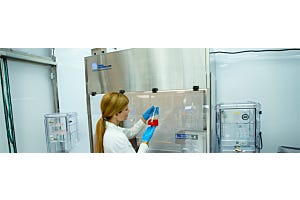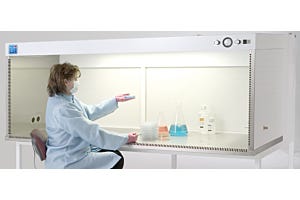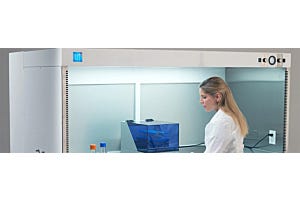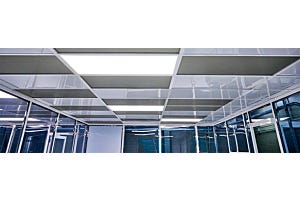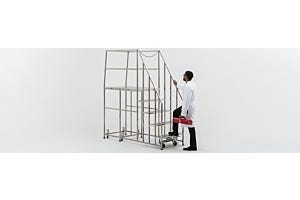Fungi Contamination in Cell Culture
Fungi proliferate in dark, damp, and warm environments which also serve as ideal environments for opportunistic pests, mold, bacteria, and plant-based viruses. Agar-based techniques are highly susceptible to contamination. Fungal contamination is difficult to reverse and quickly spreads throughout the local environments.
Non-sterile conditions during cell culture are typical contributors to the spread of mycoviruses, bacteria, mold, and yeast. Maintaining sterile conditions is critical in a wide range of cell culture success stories including pharmaceutical manufacturing, novel strain development, bio-prospecting, and synthetic byproduct production.
Laminar Flow Hoods for Mycology Culture
A laminar flow hood is one of the most effective tools for producing sterile grade conditions during the research and manufacturing of mushroom-derived biotechnology, biofuels, and medicine.
What is a Laminar Flow Hood?
Laminar flow hoods, also referred to as clean benches, are enclosed workstations with a hood-mounted HEPA fan blower. Primarily, a laminar flow hood prevents airborne contamination from encountering critical surfaces, process materials, and samples. A laminar flow hood for mushroom cultivation eliminates contamination exposure problems of a cumbersome Still Air Box (SAB). The micro-filtered clean environment inside a laminar flow hood is optimal for making and working with agar plates, spore syringes, spore prints, and much more.
Filtered air inflows continuously and prevents ambient air from flowing into the chamber via positive pressurization. Typically, the construction material preferred for mycology environments is either stainless steel or plastic polymers.
Do I need a Laminar or Horizontal Flow Hood for Mycology Laboratory?
Sterile-grade flow hoods are recommended for all laboratory, research, or manufacturing processes that require sterile or aseptic outcomes. A horizontal flow hood is common for mycology work due to its large surface area and airflow design. Horizontal flow hoods have rear-mounted HEPA filters which introduce clean air from the back of the cabinet and exhaust out the front sash. Horizontal flow is less likely to introduce contamination from upstream surfaces, operators, or instruments within the cabinet. The back-to-front airflow ensures that contamination is not recirculated in the cabinet, and ensures that gloves, garments, or tools remain downstream of critical surfaces.
Read More: Pros and Cons: Vertical vs Horizontal Flow Hoods
What Kind of Laminar Flow Hood Do I Need?
What are the Advantages of Stainless Steel Laminar Flow Hoods?
Why is stainless steel a "gold standard" for sensitive microbiology environments? First, stainless steel cleans easily and is compatible with a wide variety of aggressive chemicals and solvents. Stainless steel is well suited for cleaning and disinfection processes that require heat, irradiation, or chemical oxidizers.
View Stainless Steel Flow Hood Pricing and Packages
What are the Advantages of Polypropylene Laminar Flow Hoods?
Polypropylene laminar flow hoods offer broad chemical resistance; microbial resistance, and a strong industrial-grade surface. Meanwhile, the material is also lightweight and more cost-effective than stainless steel alternatives.
Sterile Environments for Mycology - ISO 5 Rated Mini Environments
Terra's ISO Class 5 air quality laminar flow hoods are typically regarded as the industry-standard benchmark for flow hoods that produce sterile-rated conditions. These high-performance fan filters and blower motors are well suited for almost any critical environment including axenic cell culture, micropropagation, genomics, proteomics, cell biology, and mushroom cultivation.
Achieving an ISO 5 rated classification throughout a laboratory or cleanroom environment is energy-intensive and requires constant treatment with aggressive sterilants and disinfectants. A laminar flow hood provides a HEPA filtered mini-environment that can efficiently maintain sterile-grade air grade conditions while also being easy to clean and maintain.
A standard cleanroom-grade HEPA filter is suitable for most sterile-rated (ISO 5/Class 100) environments. For more effective particle capture, ULPA filters are specified for environments that require (ISO 4/Class 10) air quality ratings.
Why Are Terra Laminar Flow Hoods Preferred for Mycology and Cell Culture?
Terra Universal laminar flow hoods are configurable with dozens of features that help reduce and eliminate cross-contamination during cell culture.
Maintain Aseptic Technique
A good aseptic technique is the most effective measure of preventing mycoplasma and other types of contamination. However, when human operators are involved, user error, inadequate technique, and improper gowning procedures are common contamination sources.
Achieve a Sterile-Rated Environment
A sterile environment implies conditions that do not host any form of microbial life, however, such conditions are extremely challenging to maintain in real-world conditions. For sterile cell culture, a laminar flow hood with a cleanroom-grade HEPA or ULPA filter can support virtually any task regarding cell culture, micropropagation, genomics, proteomics, cell biology, and mushroom cultivation.
Temporary Controlled Storage
A laminar flow hood provides a clean environment for manipulation and handling. Meanwhile, the broad surface ensures a clean storage area and easy access to sterile water, reagents, and solvents when not in use.
Create a Positive Pressure Air Buffer
Positive pressure laminar flow hoods provide ideal conditions for science and laboratory applications including wet use, contamination-prone cultures, and other non-sterile product or specimen handling.
Germfree, a leading manufacturer of laminar flow equipment, corroborates the advantage of positive pressure in laminar flow hoods, stating, "Laminar flow hoods offer a high level of localized control for critical processes or products. This is achieved by providing individual streams of positive pressure and HEPA-filtered air in a unidirectional manner. The delivery of laminar flow air along parallel lines minimizes turbulence within the work area of the hood."
Sterile Mycology Hood Features
Easy Cleaning & Chemical Resistance
Terra Universal provides a variety of flow hood with materials and accessories that improve the speed and reliability of everyday cleaning processes. For microbiological sensitive environments, stainless steel construction is beneficial because of its thermal properties, resistance to moisture, and ability to withstand harsh sterilization procedures that require aggressive chemical disinfectants, heat sterilization, and UV radiation.
Backpressure Monitoring and Smooth Airflow Delivery
Minihelic™ Back Pressure Gauges monitor the HEPA filter under load and indicate when the filter requires replacement. Air return ducts along the front and side edges minimize turbulence and therefore reduce efficiency losses when airflow encounters objects near workstation edges.
Adjustable Airflow Control
A 3-speed switch allows low, medium, and high settings with an average airflow velocity of 90+ feet per minute at 640+ CFM. The airspeed control dial on the front of the workstation is readily accessible next to the power switches for the blower and light fixture.
UV Light Decontamination for Cell Culture and Mycoplasma
Terra laminar flow hoods are available with integrated UV lighting for decontaminating the enclosure when not in use.
A UV disinfection light is effective for reducing colony forming units (CFUs) and works passively when the cabinet is not in operation. Alongside a primary cleaning regimen, far UV light provides a hands-off decontamination solution that does not require wipedown with costly sterile substrates or sterile ethanol. Importantly, UV light is more effective against mycoplasma than almost any other decontamination method.
Optional Self Sterilizing CO2 Incubators
The incubator is considered a major source of biological contamination. The repeated on/off cycles of an autoclave provide ample time for spores to germinate between cycles. Heat treatment of indoor air using thermal processes has been considered a safe, effective, and environment-friendly decontamination method.
Terra Universal provides a variety of incubation and sterilization equipment online from its laboratory equipment specialty store. With 180 °C hot-air sterilization, complete sterilization of the entire interior is available at the push of a button.
Challenges for Preventing Fungal Culture Contamination
Limitations of Antibiotics for Cell Culture Mycoplasma
The efficiency of antibiotics in the elimination of mycoplasma ranges between 66 and 85 percent. Because mycoplasmas do not have a cell wall, rudimentary sanitation with alcohol or even high-level disinfectants is usually unsuccessful.
The most common types of mycoplasma detected in labs range between (0.15-0.3µm). Mycoplasma gallisepticum, one of the smallest free-living cells, measures at a genome size of only 4.6 × 10^8 daltons. To further demonstrate the extraordinarily small size of this mycoplasma, a ~1.6 microgram [μg] sample consists of nearly one quintillion dalton. Due to their small size, antibiotic-resistant properties, and lack of cell wall, fungal cultures contaminated with mycoplasma contamination are both difficult to treat and difficult to eradicate from the air and nearby surfaces. Therefore, maintaining sterile conditions is critical in a wide range of cell culture processes including pharmaceutical research, strain development, bioprospecting, food and beverage, and synthetic byproduct research/development.
Limitations of Media and Solution Filters
Adding further complication, "Mycoplasmas can pass into the filter membranes used in sterilizing cell culture media, sera, and other reagents since they are too small and pliable due to the absence of a cell wall." (Nikfarjam L, Farzaneh P. 2012). For some applications, and laboratories with low levels of mycoplasma, a "0.2µm pore size is relatively safe for filtering media and solutions".
Limitations of HEPA Filters for Cell Culture Mycoplasma
Terra vertical laminar flow hoods include High-Efficiency Particulate Air (HEPA) filters that capture 99.97% of microparticulates at 0.3µm particle diameter. Optionally, Ultra-Low Particulate Air (ULPA) filters are available for added confidence of 99.999% efficiency at 0.12µm particle diameter.
HEPA and ULPA filtration are capable of filtering mycoplasma, even when encountering particles much smaller than the fibrous pores within the filter media. Despite the small size, the Brownian motion slows the speed of ultra-small particles and makes them more likely to impact and be intercepted by the borosilicate fibers within a HEPA filter.
Related: How Do HEPA Filters Capture Ultra-Small Particles and Some Viruses?
Why Buy A Flow Hood From Terra Universal?
Terra frequently sells laminar flow hood equipment to customers involved in horticulture, hydroponic, mycology, and mushroom cultivation.
UL Listed Components
Terra components are manufactured and certified as UL-listed products. UL listing is one of the most stringent standards for high-quality electronics and packages. Each assembly must meet strict quality and electrical safety standards throughout the manufacturing process.
American Made and Manufactured
Terra's laminar flow hoods are American-made and American assembled in Fullerton, California. Terra offers a wide variety of optional add-ons including fan filter gauges, night modes for reduced energy consumption, and various modules for monitoring air quality and pressure within the enclosure. Terra's on-shore manufacturing facilities operate under the highest quality control standards, component integrity, and lifetime value.
Need Help with Product Configuration?
Shop Terra Universal Flow Hoods and sterile processing equipment online. Immediately compare pricing or configure your cart with accessories and add-ons for checkout or quoting.
Contact a Terra sales specialist via phone, webchat, or email for help with configuration, large purchases, or application expertise.




